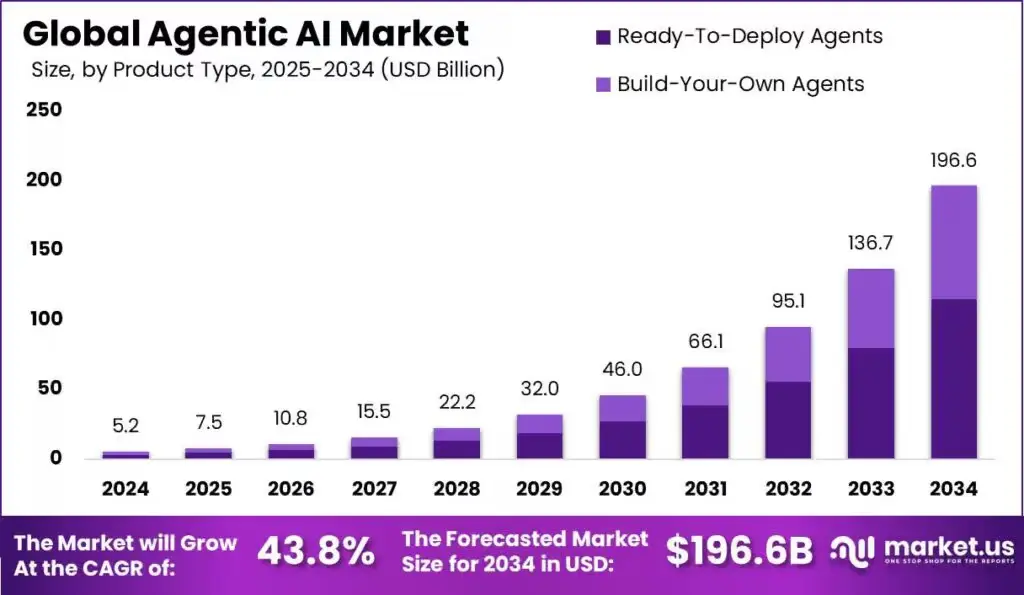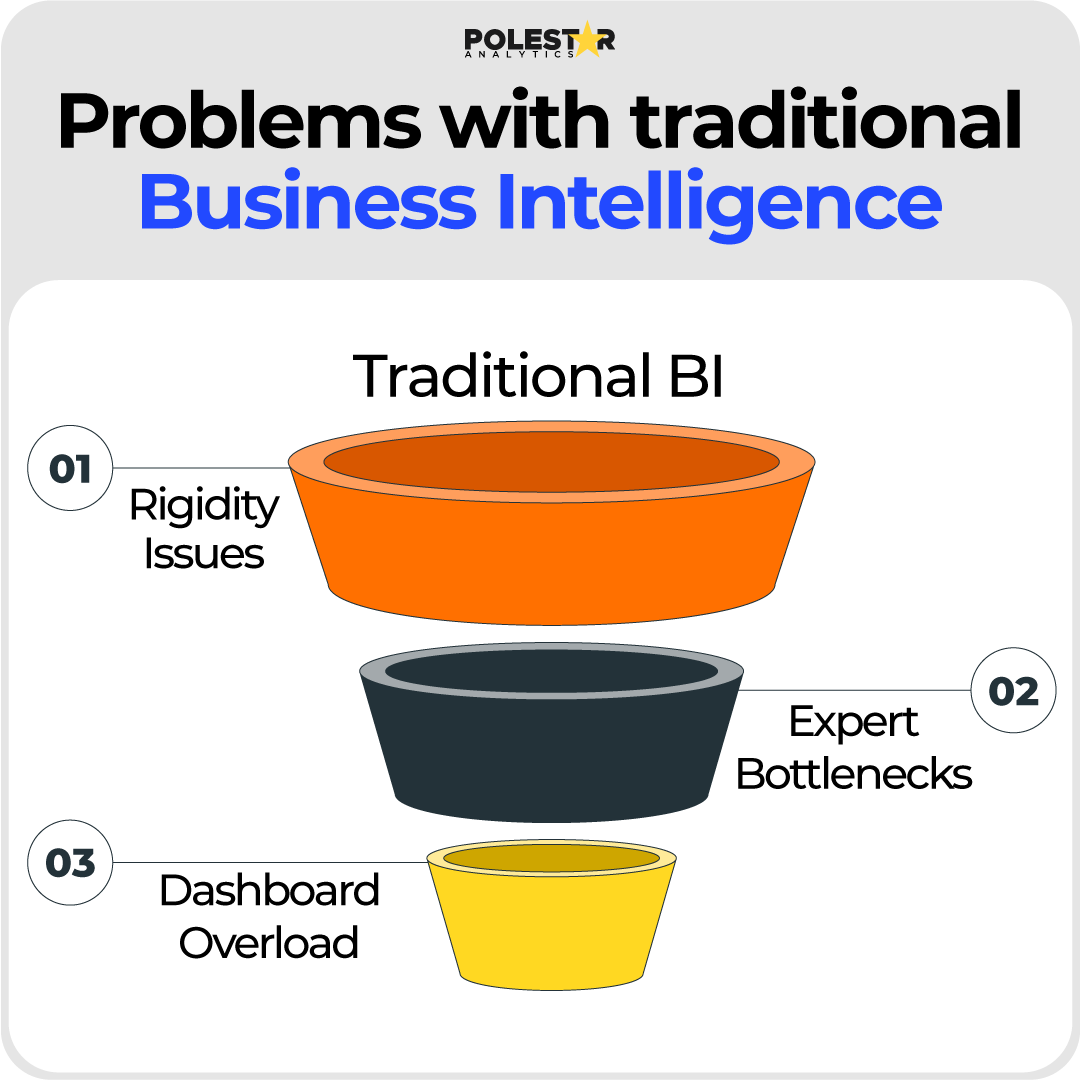
Sign up to receive latest insights & updates in technology, AI & data analytics, data science, & innovations from Polestar Analytics.
Editor's Note: For years, organizations have equated “more dashboards” with “more insights.” But as this blog reveals that approach has reached its breaking point. Agentic Business Intelligence redefines analytics—shifting from reactive reporting to proactive, autonomous decision-making. You’ll learn how AI agents are eliminating dashboard overload, enabling contextual insights, and executing real-time actions without human intervention. Continue reading.
Consider a scenario: A fortune 500 CFO confessed that they've 500+ dashboards, but we can't explain why our revenue dropped by 8% last quarter. They have a lot of unused or underutilized dashboards and most of their time went into preparing data rather than analysing it. The result? More dashboards are making them less informed.
For years, organizations have been trying to democratize analytics, i.e., to make analytics more accessible to business users. Traditional Business Intelligence has served organizations well, providing critical insights via structured reporting and analytics. But, as data volumes explode (181 zettabytes by 2025) and business questions grow more complex, the limitations of this approach have become increasingly significant. Legacy dashboards excel at answering predefined questions, but each answer often come up with another ten new queries— It's a vicious cycle of dashboard sprawl, not actual intelligence. But something is shifting. A new type of AI is emerging — one that not just wait for any directions but sets objectives, plans actions, and learns from outputs.
The next phase of AI is here - Agentic AI.
This shift presents moving from reactive analytics to proactive intelligence. Organizations are now deploying autonomous systems to replace traditional dashboards and manual analysis, enabling continuous data monitoring, insight generation, and decision execution. With market projections reaching $196.6 billion by 2034, we're witnessing the transition from experimental pilots to production deployments that transform entire business processes.

This blog explores the hidden inefficiencies of traditional dashboards and demonstrating how Agentic AI/BI is transforming the way businesses interact with data. What you'll discover may change the way you think about BI forever.
Agentic AI presents a momentous shift from traditional data visualization to active, intelligent data analysis. Unlike conventional BI tools that show charts and need users to interpret results manually, Agentic BI works as an autonomous data analyst that can:
The main innovation lies in embedding AI agents directly into the data processing pipeline, eradicating the outdated approach that has afflicted traditional BI for years. To see the difference more transparently, let's compare between traditional BI and Agentic BI processes.
| Feature | Traditional BI | Agentic BI |
|---|---|---|
| Approach | Manual and reactive | AI-driven and proactive |
| Query method | SQL-based, requires technical expertise | Natural language queries, democratized access |
| Data processing | Relies on ETL pipelines and data warehouses | Direct access with real-time streaming and autonomous processing |
| Insights | Historical, static snapshots (what happened?) | Real-time, predictive, and prescriptive (what should we do?) |
| Action | User-driven analysis and reporting | Autonomous detection, explanation, and execution |
| Intelligence | Limited to predefined metrics, filters, and reports | Adaptive, self-learning models that refine over time through feedback loops |
| Personalization | One-size-fits-all dashboards | Role-based, context-aware, personalized insights |
| Governance & Trust | Depends on manual data validation and version control | Built-in data lineage, explainability, and governance guardrails for AI decisions |
Companies invest millions in BI infrastructure, but still business users export data to Excel for actual analysis. Why? Dashboards track metrics, but they rarely answer deeper questions. If a filter is missing or you need a new metric, users have to export data to Excel or wait for your data team to create a new report. This is called the "last-mile problem" in analytics. Let’s us break down why this keeps happening:

Rigidity issues: Traditional BI tools rely on fixed semantic models, which can only answer questions that were anticipated and “pre-modeled” in advance. These rigid structures leave organizations with outdated insights limiting their adaptability, leading to inconsistent results.
Expert bottlenecks: Business users can't access insights independently—they stuck waiting for BI teams to build dashboards or answer ad-hoc questions. When a sales manager needs custom analysis, they submit requests and wait weeks for delivery. This dependency creates cascading roadblocks- insights arrive too late to act on, decision-making slows immensely, and opportunities goes away while requests queue up. In such situations,businesses unable to respond at market speed and teams invest more of their time waiting for reports while actually making data-driven decisions tedious.
Dashboard Overload: Organizations accumulate thousands of dashboards over time, each built for specific teams or use cases. The problem is not just volume—it's fragmentation and discoverability. Finance has one version of customer revenue metrics, sales and marketing has another. Business users waste valuable time searching through endless dashboards trying to find the right KPI or the "correct" version of the truth. Even when they locate the right dashboard, it only shows what happened—a static snapshot of past performance. There's no context explaining why metrics changed, no proactive alerts on anomalies, and no guidance on what actions to take. Users end up exporting data to excel to do their own analysis anyway, hindering the entire purpose of the BI investment.
Agentic AI embedded to your existing BI workflows has the potential to reshape how your org activates data and turns it into actionable intelligence. Have a look:
Conventionally, deep data analysis was limited to skilled data analysts who understands how to build reports and query complex databases. Agentic AI democratize data analysis by making it more accessible to wide audience within an org.
Before insights are generated, data must be cleaned, validated, and prepared — conventionally one of the most time-taking stages that precedes BI. Agentic BI platforms can automate this layer:
Beyond explaining what happened or predicting what might happen, Agentic Business Intelligence systems through tools like Insights Portal powered by 1Platform now recommend the next best action and even execute the best course of action. This capability is managed by the decision layer, Agenthood AI, which acts as the "heart or brain" of the system, converting base data and enriched data into suggested actions.
Gartner points out in it research that by 2028, 70% of AI applications will utilize multi-agent systems. This will help business functions and ecosystems to provide holistic performance assessments, which will take business intelligence to the next level. In the current challenging business scenarios, numerous specialized AI agents can collaborate to resolve multifaceted issues across disparate systems, like -
The leaders should look at the key metrices which involves - user adoption rates, quality and speed of taking business decisions powered by AI-infused insights, alignment of outcomes with business goals, compliance with data governance standards, and decrease in reporting cycle time.
Embedding Agentic AI in BI offers numerous benefits that include:
Both traditional and Agentic BI rely on data pipelines, warehouses, and analysts—but Agentic Business Intelligence uses them far more intelligently. It automates data preparation, reduces manual ETL work, and enables faster, more autonomous insight generation. The result is swift adoption, low operations cost, and high ROI via intelligent utilization of existing infra.
With Agenthood AI, you’ll go from “analyzing dashboards” to “autonomous decisions” faster than you can say data overload.
Create your first AI agentExplore the Agentic AI Implementation guide and unlock the 4-step framework to scale intelligent, self-driving Business Intelligence.
Henceforth, it can be understood that Agentic AI in business intelligence marks a revolutionary change from dashboards to goal-centric intelligence. Despite mere reporting, it capitalizes businesses to anticipate, learn, and act in real-time.
The road ahead for business intelligence lies in systems that not just inform decisions but actively accelerate them. That’s where Agenthood AI comes into play. Built to operationalize Agentic BI, Agenthood AI understand teams and leaders with proactive, conversational intelligence aligned with your business goals.
Hence, if dashboards defined the last decade of BI, Agentic AI will redefine the next. Get in touch today!
About Author

Content Architect
The goal is to turn data into information, and information into insights.